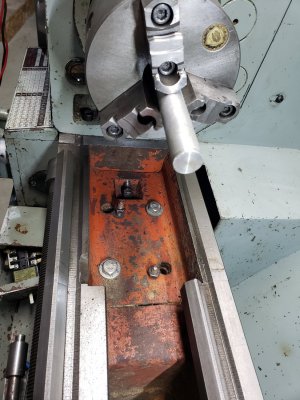-
Welcome back Guest! Did you know you can mentor other members here at H-M? If not, please check out our Relaunch of Hobby Machinist Mentoring Program!
You are using an out of date browser. It may not display this or other websites correctly.
You should upgrade or use an alternative browser.
You should upgrade or use an alternative browser.
Drop bed lathe
- Thread starter Larry$
- Start date
- Joined
- Dec 21, 2018
- Messages
- 1,816
Pretty sure you are right!I don’t think it left the factory this way
- Joined
- Dec 9, 2021
- Messages
- 735
Those two "studs" with the nuts on them are the guide pins. You can remove them by tightening the nuts. You may have to stack washers under the nuts to get them all the way out. Once the guide pins are out, remove the other fasteners and the gap will come loose. With the chuck removed, you can carefully lift it up and out.this lathe is very new to me and I haven’t actually run it yet. Heres a pic of the gap section as it’s installed now, I don’t think it left the factory this way
View attachment 432557
Examine all the mating surfaces and remove any chips or foreign matter. Stone out any raised material on both the gap and the lathe bed. Clean the threads, bores, and counterbores of the fasteners. If any threads are damaged, repair them with a Helicoil or similar method. Clean all mating surfaces and apply a thin film of way oil, then reassemble. install the guide pins first by starting them by hand (or gently tapping with a small soft hammer or brass drift until you are sure they are started into the holes in the lathe bed. Once they are started, you can use the brass drift to seat them. They have a reduced diameter so you can bell out the end and still get the nut off, but by being careful they will go back in without damage.
I think the prior owner may have hated metric fasteners and modified the lathe to use the hex bolts. Perhaps he damaged the original fasteners or threads. You will find out when you disassemble the gap.
I had a poor fitting gap on the 13x40 I bought used. It had a "step" where the ways joined the gap, with the gap slightly raised. Upon disassembly, I discovered several chips imbedded in the mating surfaces that were causing the misalignment. I used the procedures described above to remedy that and it all went back together with perfect alignment. I didn't have to fix any damage other than remove the raised burrs on the mating surfaces.
- Joined
- Nov 1, 2022
- Messages
- 140
Thanks for the detailed instructions. It may be a while before I get to this, i just got the 220v run, plugged in the lathe turned it on and… nothing. The PO had passed away and I bought this from his widow, but I was under the impression it “ran when parked”.
- Joined
- Jan 30, 2017
- Messages
- 261
I am considering buying a 16x40 Cadillac lathe. How do you like the one at your work?We have one at work. A 14” Cadillac. That one is bolted and doweled. Nice snug fit not too hard to remove. Make sure everything is clean when putting back in.
Only remove when you need it.
Cutting oil is my blood.
- Joined
- Nov 17, 2017
- Messages
- 1,525
Several years ago when Keith Fenner was tuning up his 14" lathe, he removed the gap-bed and replaced it (later) showing how to use dial indicators so the gap goes back where it started from.
- Joined
- Apr 23, 2018
- Messages
- 6,577
Did he do it as a proof of concept, or out of necessity? Cleaned surfaces and tapered pins should align reliably without much fuss.Several years ago when Keith Fenner was tuning up his 14" lathe, he removed the gap-bed and replaced it (later) showing how to use dial indicators so the gap goes back where it started from.
- Joined
- Nov 17, 2017
- Messages
- 1,525
Did he do it as a proof of concept, or out of necessity? Cleaned surfaces and tapered pins should align reliably without much fuss.
Cleaned, oiled surfaces SHOULD be enough, but the video shows him using a dial indicator mounted on the apron and measuring both sides of the -v- standing above the flat tracks. I don't remember if he had to tap it with a hammer.


